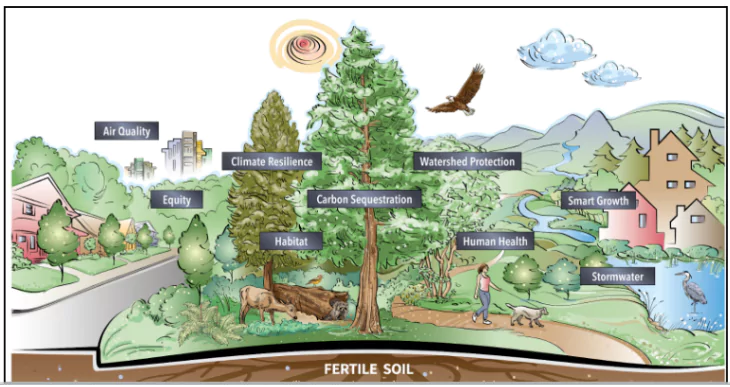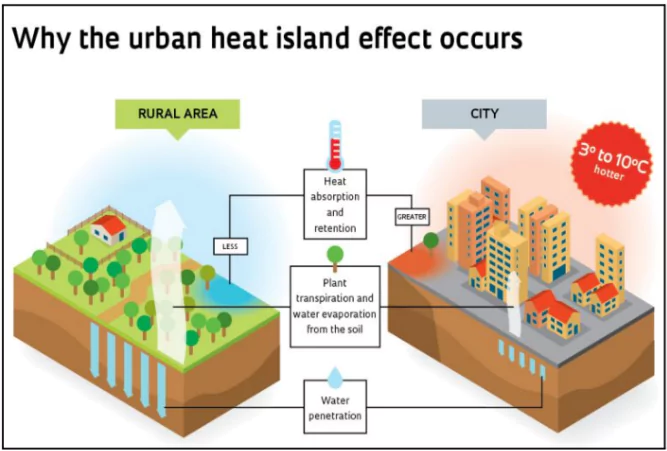Recently, the Supreme Court intervened to halt deforestation in Kancha Gachibowli, Hyderabad, underscoring the vulnerability of India’s urban forests to development pressures.
- The theme for International Day for Biological Diversity this year (observed annually on May 22) is “Harmony with nature and sustainable development”.
- The date commemorates the adoption of the text of the Convention on Biological Diversity (CBD) on May 22, 1992.
Case Studies of Successful Urban Forests
- Danube-Auen National Park, Vienna (Austria):
It supports diverse habitats and helps regulate local climates while enhancing public access to nature within a city context.
- Peri-Urban Forest Ostend (Belgium):
Created on former agricultural land, this forest acts as a biodiversity buffer between industry and residences.
- Landscape Park Duisburg Nord (Germany):
Transformed from an industrial site, this park combines climate regulation, water management, and cultural heritage preservation.
|
What is Urban Forest?
- Urban forests refer to tree-dense areas and green corridors within city limits that include natural woodlands, man-made parks, and institutional green belts.
- Urban biodiversity encompasses the variety of living organisms, flora, fauna, fungi, and microorganisms thriving in these spaces.

Key Urban Forest Sites in India
- Aarey Forest (Mumbai)
- Ridge Forest (Delhi)
- Turahalli Forest (Bengaluru)
- Kancha Gachibowli (Hyderabad)
Benefits of Urban Forest
- Ecological Balance and Air Quality: Urban forests help filter air pollutants such as PM 2.5 and PM 10, sequester carbon, and regulate urban temperatures.
 A U.S. Forest Service study found that one hectare of urban forest can remove up to one ton of air pollutants annually.
A U.S. Forest Service study found that one hectare of urban forest can remove up to one ton of air pollutants annually.
- Climate Resilience: Urban greenery mitigates the Urban Heat Island Effect, reduces stormwater runoff, and helps prevent urban flooding.
- Trees also stabilize soil and reduce erosion during heavy rainfall.
- Support for Biodiversity: Green spaces serve as refuges for endangered and urban-adapted species such as birds, butterflies, and insects.
- In Chennai’s Koyambedu market, natural regeneration led to 141 plant species and 35 bird species in just two years.
Urban Biodiversity Conservation and Urban Flood Mitigation
- Natural Water Absorption: Green spaces with native vegetation enhance soil permeability, allowing rainwater infiltration and reducing surface runoff.
- Wetland Restoration: Conserving and restoring urban wetlands acts as natural sponges, storing excess rainwater and releasing it slowly.
- Rainwater Harvesting: Biodiverse landscapes integrated with sustainable architecture promote rainwater capture and reuse.
- Stormwater Regulation: Trees and vegetated buffers intercept rainfall and reduce the velocity of stormwater, minimizing flash flood risks.
- Ecosystem Buffer Zones: Urban forests and parks act as buffer zones along water bodies, preventing encroachment and improving floodplain resilience.
- Microclimate Regulation: Urban greenery reduces the urban heat island effect, supporting better evapotranspiration and localized rainfall regulation.
|
- Social and Cultural Services: Urban forests promote public health through temperature regulation and stress relief.
- They serve as recreational and cultural spaces for spiritual, educational, and physical activities.
- Supports SDG: Urban Forest helps in achieving SDG goals.
- SDG 11 states the importance of making cities and human settlements safe, resilient and sustainable.
Government Initiatives on Urban Biodiversity
- Nagar Van Yojana: Launched in 2020 by Ministry of Environment, Forest and Climate Change (MoEF&CC) it aims to create 1,000 urban forests by 2027.
- As per the India State of Forest Report 2023, 1,445.81 km² of green cover has been added under this scheme.
- Smart Cities Mission and AMRUT (2015): These missions promote integrated ecological design in urban infrastructure, including biodiversity corridors, sustainable drainage systems, and eco-parks.
- National Forest Policy (1988): Emphasizes social forestry and community participation, encouraging urban residents to engage in tree planting and green space development, thereby supporting the creation and protection of urban forests.
- National Mission for Green India (2014): Aims to enhance forest cover and ecosystem services, promoting afforestation in urban areas to improve air quality and climate resilience.
- Adaptation of Modern Techniques: Cities like Mumbai, Delhi, and Chennai have adopted Miyawaki technique to restore degraded spaces and create green lungs.
- Biodiversity Parks: Based on the outcomes of the DDA Biodiversity Parks, the MoEF&CC has launched a scheme to establish biodiversity parks in states and union territories across the country.
- Biodiversity Parks such as Yamuna Biodiversity Park in Delhi restored wetland ecosystems and supports over 1,500 species of flora and fauna.
Global Initiatives for Urban Biodiversity Conservation
- UN Habitat’s 3-30-300 Principle: This urban greening guideline promotes equitable access to nature by ensuring:
- A view of at least 3 mature trees from every home
- A minimum 30% tree canopy cover in each neighbourhood
- A public green space within 300 meters of every residence .
- Kunming-Montreal Global Biodiversity Framework (GBF): Adopted under the Convention on Biological Diversity (CBD), the GBF sets 23 global targets.
-
- Target 12 calls for enhancing urban green and blue spaces to boost biodiversity, ecological connectivity, and well-being by 2030
- Frankfurt’s Green Belt Model: Frankfurt established a circular green belt that serves as a climate buffer. Studies show it reduced city temperatures by 3.5°C and increased relative humidity by 5% compared to the urban core.
Challenges to Urban Forests and Biodiversity
- Declining Urban Biodiversity: Urbanisation leads to a loss of habitat for insects, birds, and rodents, impacting ecological networks.
- For instance, as per the Forest Survey of India latest report Chennai lost 2.6 sq. km of green cover between 2021–2023.
- Design Hazards: Most urban buildings lack biodiversity-supportive designs.
- Concrete-dominated architecture does not accommodate nesting birds, rooftop gardens, or green facades.
City Biodiversity Index (CBI)
- City Biodiversity Index (CBI): it is self-assessment tool developed by the Convention on Biological Diversity to measure and monitor urban biodiversity performance.
- It is prepared based on the present status of the city in terms of three large parameters:
- The extent of native biodiversity in the city,
- Ecosystem services provided by them
- The level of governance of biodiversity.
- LBSAPs (Local Biodiversity Strategy and Action Plans): City-specific frameworks aligning with national biodiversity goals to guide local conservation actions.
- Purpose:Both tools promote ecosystem preservation, sustainable urban planning, and data-driven policy.
- Implementation: Adopted by cities like Kochi and Gangtok through ICLEI-Asia, encouraging community and governance participation in biodiversity planning.
|
- Loss of Blue and Green Infrastructure: Encroachment and pollution have severely degraded urban wetlands and lakes.
- Example: The Pallikaranai marshland in Chennai was once a wasteland but is now a Ramsar site after partial restoration.
- Climate Change Pressures: Urban flooding and rising temperatures are exacerbated by loss of permeable land which in turn impact the Blue – green Cover of the cities.
- Delhi’s AQI reaching 494 in 2024 highlights how vegetation loss compounds pollution.
Way Forward for Urban Biodiversity Conservation
- City Planning Tools: Cities must adopt the City Biodiversity Index and prepare Local Biodiversity Strategy and Action Plans (LBSAPs).
- Successful examples include Kochi, Gangtok, and Nagpur, where biodiversity-informed urban policies are being implemented.
- Green Urban Design: Mandating green spaces per housing plot, tree-lined streets, and wetland buffers in city master plans will ensure integration of ecology into infrastructure. For instance, the Greater Chennai Corporation plans require tree planting for larger plots.
- Native Species Promotion: Awareness campaigns about the ecological value of native plants can check monoculture plantations.
- Chennai’s greening effort such as Koyambedu Model added over one million native trees since 2018, aiding local fauna and ecosystem regeneration.
| Aspect |
Koyambedu Model |
Miyawaki Method |
| Introduction |
Developed in Chennai, this model integrates urban forests into utility spaces like sewage treatment plants. |
A Japanese method by Dr. Akira Miyawaki, widely used for dense native forests. |
| Plantation Approach |
Uses native species in spacious layouts, combining greenery with infrastructure. |
Dense multi-layered plantations with 3–4 saplings per square meter. |
| Focus |
Urban resilience, utility-based greening, and ecological restoration. |
Rapid afforestation, biodiversity enrichment, and microclimate regulation. |
| Time of Maturity |
Takes 5–10 years depending on species and space. |
Forest matures in 2–3 years with minimal maintenance post-growth. |
- Public Engagement: Community participation is vital.
- Delhi’s initiatives of public plant distributions and rooftop garden schemes have empowered citizens to contribute directly to greening and pollution control.
- Nature-Based Solutions (NbS): Deploying NbS like Miyawaki forests and constructed wetlands enhances biodiversity while managing stormwater and pollution. These ecological approaches are cost-effective and resilient.
- Incentivised Architecture: Encouraging biodiversity-friendly architecture through incentives for rainwater harvesting, green walls, and biodiversity buffers can transform even high-density housing into ecological assets.
- Ecological Finance: Introduce green budgeting by linking tax rebates and urban development grants to biodiversity performance. This aligns economic incentives with environmental goals.
Conclusion
India’s urban future must align with ecological sustainability. Urban forests and biodiversity must be central to city planning and citizen participation. Judicial vigilance, government programs like Nagar Van Yojana, and innovative city designs must converge to build breathable, equitable, and climate-resilient urban ecosystems. Development should enhance and not endanger nature in our cities.
![]() 23 May 2025
23 May 2025


 A U.S. Forest Service study found that one hectare of urban forest can remove up to one ton of air pollutants annually.
A U.S. Forest Service study found that one hectare of urban forest can remove up to one ton of air pollutants annually.